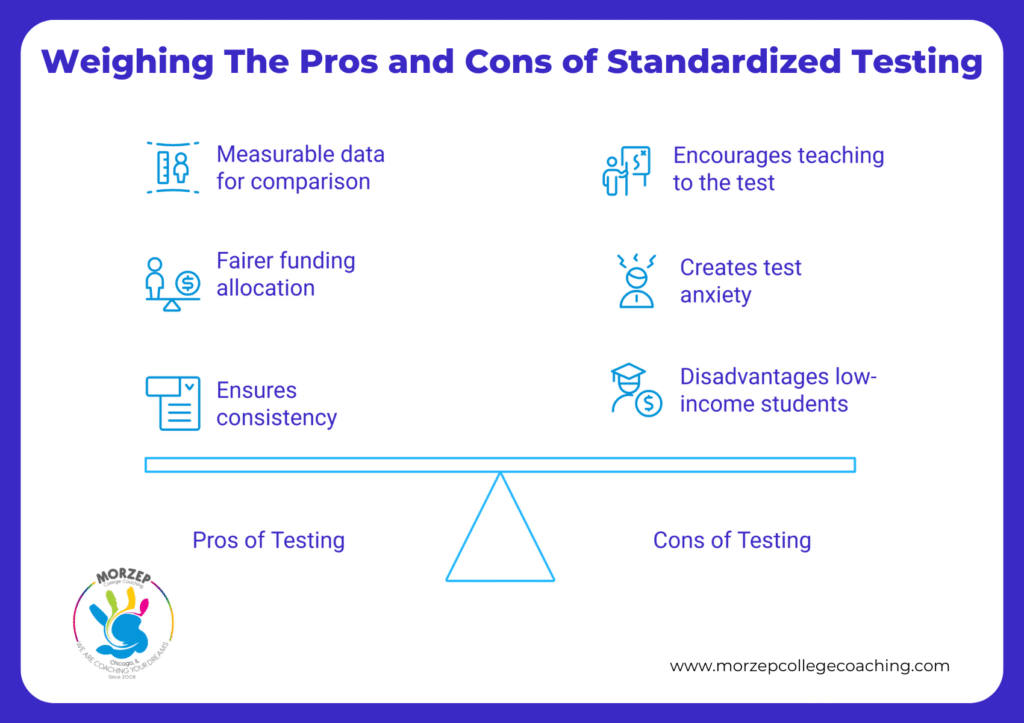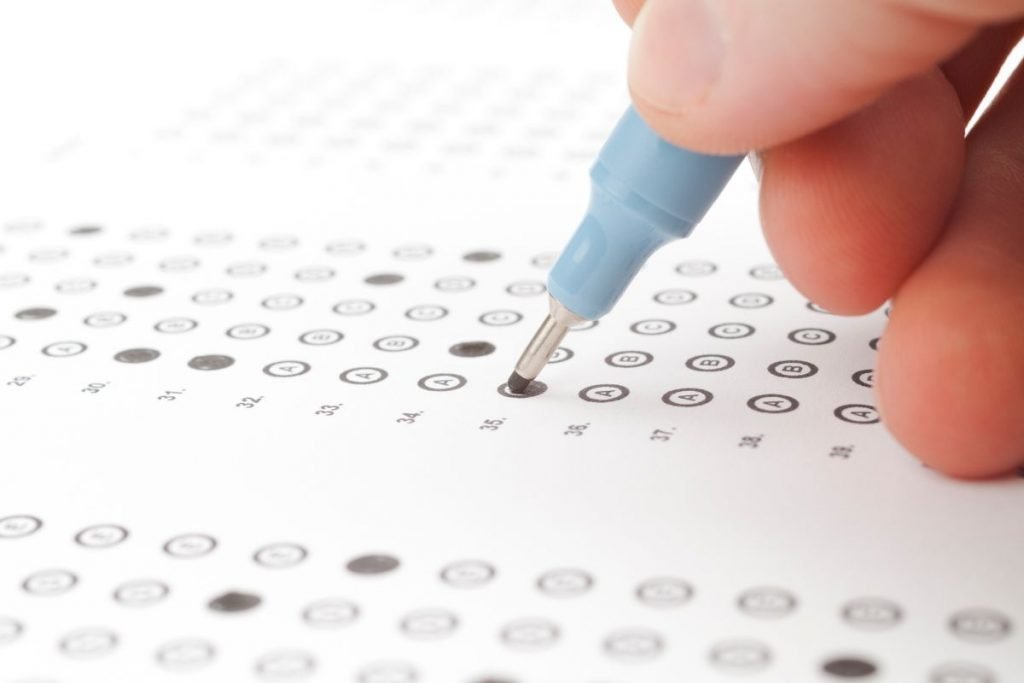Although they are not perfect tools to measure college success, standardized tests are high-stakes examinations designed to remove bias and favoritism from scoring student learning.
How are standardized tests in the United States employed during the application process? How can you ace them, and do you need standardized tests? In this guide, you’ll find important details on:
- The reason why standardized tests are important during the college admission process
- How standardized test results provide valuable information
- The history of standardized exams
- The pros and cons of standardized admissions
What Is Standardized Testing?
According to the Glossary of Education Reform, a test can be defined as a standardized test if it follows two primary criteria:
- The test must be formulated in such a way that all test takers answer the same questions (or a subset of questions that come from a shared bank of questions) in the same way
- The test must be scored consistently so that performance comparisons can be drawn for individuals or demographics
History of Standardized Tests: What Are Standardized Tests Used for Today?
The first ideas about formally assessing a student’s progress and academic achievement came about in 1838 from American schools and educators.
Before and during the American Civil War between the Union and the Confederacy, written tests began to replace oral examinations in the education system. The achievement tests were given by individual teachers and schools, and even became mandated.
The standardized testing practices we think of today became widespread at the beginning of the 20th century, and the establishment of the College Entrance Examination Board in 1901 led to more comprehensive testing and high-quality education for the masses in the following decades.
The push for higher education for all was, unfortunately, tainted with racism at an early stage, such that black students have experienced a century of discrimination in high-stakes standardized tests.

The first Scholastic Aptitude Tests (SATs) as we know them today were administered in 1926, and quickly afterward, sentiment toward standardized testing took a downturn from its previously desired and approved methods.
Standardized testing saw the rise of computerization in 1935, drastically changing how quickly students could expect to receive their scores as well as lowering the cost of testing from $5 to $.50.
Despite research about the negative impacts of the overuse of standardized tests and dwindling support for how current standardized tests operate, the No Child Left Behind reform in 2001 meant that most students had examinations not only for college admission but also after each year of grade school.
In 2015, the Every Student Succeeds Act (ESSA) was passed. This reduces the number of standardized tests students experience and dismantles how testing impacts important decision-making processes.
The Coronavirus pandemic even forced the suspension of standardized testing in public education at the height of the pandemic.
What is an example of a standardized test?
A well-known standardized test in the U.S. is the SAT. It’s been part of education since the Secondary Education Act of 1965 and later shaped by the No Child Left Behind Act.
How Standardized Tests Are Designed and Scored
A standardized test is the same for all test takers at the time of administration, but that doesn’t mean all standardized test scores are the same.
Generally, a standardized test contains a multiple-choice set of questions designed to test your understanding and critical thinking abilities based on a select few subjects. These subjects tend to be literacy (reading and writing skills) and mathematics, although some tests will go further and test you on concepts of science.
More specialized standardized tests examine your knowledge of subjects surrounding particular career paths, such as the Law School Admission Test (LSAT) or the Medical College Admission Test (MCAT) for entrance to medical schools.

Each test report scores slightly differently from the next. For example, the SAT has two sections: evidence-based reading and writing, and math tests. Student performance generates a raw score in both sections, which is converted to a benchmark scale score between 200 and 800 (400-1600 total score). This accounts for how tests can be easier or more difficult depending on the high school year in which they are taken.
The SAT used to have a penalty for answering a question incorrectly, which would negatively impact your score for guessing answers, but at the time of writing, there is no such deduction.
Pros and Cons of Standardized Testing in the US
American students are no longer required to take standardized tests throughout mandatory American education to see if they are college-ready, except in just a few cases, but standardized tests continue to be a valuable tool for students to assess their academic progress.
Let’s learn the pros and cons of this system.

Pros of standardized testing:
- Provides measurable data to compare students across state standards and state school systems.
- Helps the Department of Education and local districts allocate school funding more fairly.
- Ensures that students take the same multiple-choice test under similar testing conditions, allowing consistency.
- Can show whether students are on track to graduate from high school and maintain a solid graduate record for graduate programs later on.
- Holds schools accountable, highlighting areas where low-income students or underserved groups may need more support.
Cons of standardized testing:
- Encourages “teaching to the test” rather than deeper learning, limiting creativity in the classroom.
- Creates test anxiety and stress, especially during high-stakes testing.
- Critics argue that results don’t always reflect the true effectiveness of our education system.
- The pressure of exams can disadvantage low-income students who may not have equal resources.
- Many argue it’s time to abolish or rethink these exams, since the drawbacks of standardized testing sometimes outweigh the benefits.
Many students between 3rd and 8th grade face annual testing to determine their progress and grades in comparison to their peers. High school students partake in these types of tests in preparation for college education.
The tests are used to assess if institutions within the public school systems are in educational compliance with standards set out by the national education department.
What are the three types of standardized tests?
The main types are:
Achievement tests – measure what you’ve learned.
Aptitude tests – look at skills and potential.
College admissions tests – like the SAT or ACT, used to compare students for higher education.
Most Popular Standardized Tests Across the United States
There is a variety of standardized tests available for students, and most of them are accepted by colleges and universities in the United States as part of the admissions process.
SAT (Scholastic Assessment Test)
The SAT is the most popular standardized test that a high school graduate has to take to secure college admission.
It is a three-hour multiple-choice exam that tests students’ reading, writing, and math skills. The Critical Reading section measures students’ ability to understand and analyze written passages. The Mathematics section measures students’ ability to solve mathematical problems. The Writing section measures students’ ability to write clearly and effectively.
SAT is typically taken by high school juniors and seniors. Most colleges and universities in the United States recommend that applicants take the SAT as part of the admissions process, and preparation for it is often included in the school curriculum.
ACT (American College Testing)
The ACT is a standardized test used to measure students’ academic abilities and skills. The ACT consists of four sections: English, mathematics, reading, and science. Students who take the ACT are typically in their junior or senior year of high school.
AP (Advanced Placement) Exams
The Advanced Placement (AP) exams are standardized tests administered by the College Board and consist of a variety of subjects. Students who take the AP exams are typically in their junior or senior year of high school. AP exams could lead to earning college credits.
PERT (Postsecondary Education Readiness Test)
The PERT is a three-hour test that consists of three sections: English, mathematics, and reading. It is a placement test that determines which level of coursework a student is ready for. The PERT is typically taken by high school juniors and seniors.
PSAT (Preliminary Scholastic Assessment Test)
The PSAT is a two-hour test that consists of two sections: Critical Reading and Mathematics. It is a practice test for the SAT often taken by juniors in high school to help students prepare for the SAT.
11th-grade students who receive high PSAT scores can be nominated as a National Merit Scholar or get special recognition per ethnic group.
Do standardized tests measure critical thinking skills?
Not really. Since most rely on multiple-choice tests, they focus more on memorization than problem-solving.
Other Standardized Tests
Students can take various achievement tests, aptitude tests, and intelligence tests apart from the ones mentioned above.
Achievement tests measure what a student knows and has learned in school. These tests usually focus on academic subjects such as reading, writing, and mathematics. Aptitude tests measure a student’s ability to learn new material or perform certain tasks. Intelligence tests measure a student’s cognitive abilities and provide information about their intellectual potential.

Are Standardized Tests Effective? Let’s Talk!
Navigating the long list of standardized tests used to assess student performance can be challenging. While standardized testing in education has its role, there could be some individual requirements and differences from one college’s admission process to the next.
Morzep coaches can offer guidance and ensure success in college and beyond. Get in touch now for more information on the application process and what it takes to optimize chances of admission.





